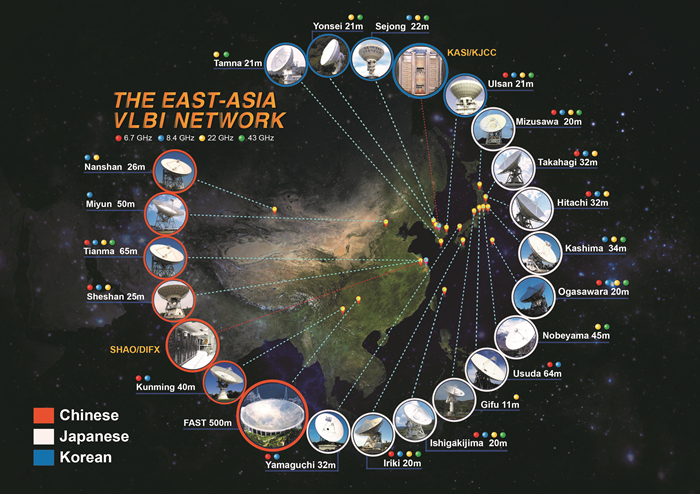Keywords: VLBI, EAVN, radio, collaboration
East Asia Very Long Baseline Interferometry (EA VLBI Network, EAVN), a network composed of 21 radio telescopes from China, Japan and South Korea, has been astronomically operational and will begin scientific commissioning soon, according to information released recently by scientists.
The fully-operated EAVN, with diverse sub-array configurations and frequency setups, is expected to cover a wide range of areas including maser studies (e.g. hydroxyl, methanol, water from star forming regions and SiO masers in late-type stars; and extragalactic maser sources), transients (e.g. pulsars, supernovae, gamma-ray bursts), jets of active galactic nucleus, space exploration and tracking, astrometry and geodesy.
Some new telescopes are under construction (e.g., 110 meter telescope in Xinjiang, China) or planned (Thailand VLBI network, the expansion of KVN), continuously enlarging the EAVN family and increasing its performance significantly.
EAVN’s full operation will yield a high angular resolution similar to a telescope with an effective diameter of thousands kilometers.
“Compared with some existing VLBI networks, the EAVN is in a state of gradual, steady growth over the past few years. It not only integrates the resources and expertise in East Asia, but also fosters stronger regional collaboration in order to maximize science and technology developmental gains.” Dr. AN Tao, a researcher from the Shanghai Astronomical Observatory of the Chinese Academy of Sciences said.
AN and his collaborators on the project, Dr. SOHN Bong Won (Korea) and Dr. IMAI Hiroshi (Japan) published a paper on Nature Astronomy today, introducing the capabilities and prospects of the network.
The EAVN is expected to play a major role in building a worldwide radio telescope network for the next generation. Such academic collaborations in East Asia will provide a great opportunity to expand the discovery fields in astronomy and space science and form a successful model of international academic collaborations with a sustainable operation scheme.

Figure 1: The geographical distribution of the EAVN telescopes, including 21 telescopes with sizes ranging between 11m and 500 m (FAST), with baselines spanning between ~6 - 5000 km, typically operational in the 2.3 - 43 GHz (ten billion Hz) frequencies. The highest resolution is about 0.5 mas at 22 GHz. More telescopes (e.g., under-construction 110 meter telescope in Xinjiang, China, and the planned Thailand VLBI network) in the near future will even broaden the science capability of EAVN. (Image by AN Tao et al./Nature Astronomy)
Link to the Science Paper:
https://www.nature.com/articles/s41550-017-0277-z
To learn more about the EAVN, please contact:
AN Tao, Shanghai Astronomical Observatory (http://www.shao.ac.cn), the Chinese Academy of Sciences, antao@shao.ac.cn